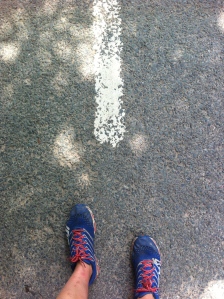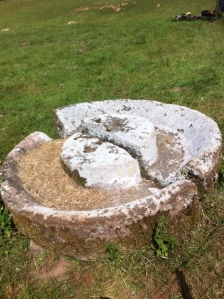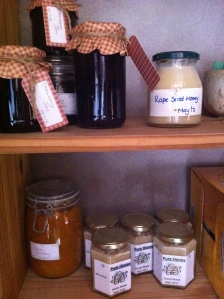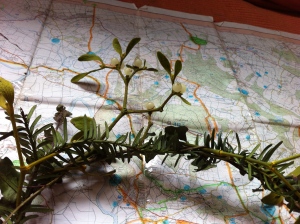All in a Day's Walk
A month-long slow food walking performanceArchive for hens
This little piggy went to market
A walk to Ruardean again to buy vegetables and meat. We have another friend – Jessie – coming for dinner later and I want to see what new produce is springing forth from the Crooked End garden since the last time I visited. In terms of local produce, I seem to have timed this summer version of the performance perfectly as a walk up a seasonal produce see-saw: it was nearly at rock bottom when I started the uphill climb but now I’ve passed the fulcrum and it’s tipping me downhill into overabundance. (Though I’m still struggling to find enough stodgy carbohydrates to support a long distance walking practice – or my own metabolism’s pace and eccentricities – but more on that anon.)
I’m walking without the dogs this time, so I’m much speedier (stiles and sniffing slow you down with hounds). But I seem to ‘read’ landscape according to my very first encounter with it, so this second walk along a route I first encountered with dogs I’m remembering the stiles that were impossibly hard to throw a hound over, or the fields of sheep where I keep them close to me (dogs chase sheep), or cows where I don’t (cattle chase dogs and I’ve been told it’s best to let your dogs off the lead to avoid being trampled yourself).
I also realise that, when I’m focused on the young dogs (are they safe? are they within sight? are they chasing something they shouldn’t?), I am experiencing the landscape more through the things their multiple senses (eyes, ears and snouts) alert me to. I have a lesser sense of the topography and terrain and my own physical or emotional response to it; it even subdues my awareness of the immediate discomfort of nettle stings. But walking this route again, which takes me up over Lea Bailey and into the Forest of Dean proper, I am more aware this time of leaving the familiar pastoral landscapes of South Herefordshire and entering labyrinthine woods with a concomitant sense of wildness and enclosure but also, paradoxically, vastness. (I remember a reading in a John Wylie paper a Gaston Bachelard quote: ‘we do not have to be long in the woods to experience the always rather anxious impression of “going deeper and deeper” into a limitless world’.)
Thinking again of landscape empathy, I realise that (of course) our true ‘sense of place’ is much more closely allied to our personal awareness of or relationship with topography and scale and the ‘recognisableness’ of landscape than administrative (county) boundaries (which I tend to be geekily hyperaware of, having worked as a landscape mapping officer for two local government authorities over the past decade). Even though we live in South Herefordshire, my partner always says by way of explanation to others that ‘we live in the Forest of Dean’. It used to intrigue my pedantic self, because strictly speaking we don’t, but now I get it: it is a highly characteristic and more recognisable and descriptive landscape area which I already feel an affection and affiliation towards. Landscapes are, of course, better defined by the perceptions of the people within them.
I also realise that it’s by situating ourselves firmly in our own filltir sgwar (a Welsh phrase, literally translated as ‘square mile’ but meaning that place which you own through familiarity and which ‘owns’ you [and] needs your vigilance), that we can begin to address wider concerns, because it gives us a context: while such a localised practice as mine could be accused of parochial tendencies, I feel that by settling in, I’m better placed to look out. As long as I don’t fall into the trap of thinking that this rural idyll is all there is. (It’s OK, they sell the Guardian in the village shop.) Having recently watched Quadrophenia for the first time (I’m a few decades behind when it comes to popular culture), it makes me think that as we become separated from landscape, we become artificially tribal: inventing difference to cultivate an ultimately flawed sense of belonging to something, anything.
These musings aside, it’s when I’m passing the stile that I remember as most hideously dog-bothersome, that I see some beehives in a next door garden. I also see some people, and stop to ask them about bee-keeping (we are thinking of getting a hive for the garden). They – Steve and Sarah – are immediately helpful and welcoming. We get talking about bees, but also the project more widely, local food and meat: it turns out they have pigs, hens and a whole smallholding of wonderment. (Even peaches in the greenhouse.) Sarah kindly takes me on a tour of the pigs, the fruit canes, vegetable garden and, finally (and most surprisingly) ‘parma’ hams hanging in the cool under a tree in their garden (though, as Sarah explains, they can’t be sold as parma ham because this is an EU PDO… and we’re full circle back to our allegiance with place and landscape). She muses, they might call them ‘Harechurch Hams’ and you can hear an audio walk through the journey from farrowing pen to tree here:
Winter solstice
It’s the winter solstice which is the event I now choose to celebrate – with food, conviviality, warmth, gifts – as my mid-winter festival of choice. (Not that I’m completely bah humbug about the big C – I’m even walking to Putley for carol singing tonight.) All in a Day’s Walk has thrown this into an even sharper focus this year – the presence of daylight (or not) has been very much present for me in my daily life in walking and even eating. Eggs – my precious only source of local protein – have been harder to come by, because the shorter days are also the reason why the hens on the farm are laying less. (A connection I hadn’t considered before.)
I’m not a very conscientious celebrant, but it feels important to mark this turning point – the ‘standing still of the sun’ – as I’m walking underneath it.
‘The great cosmic wheel of the year… the symbolic wheel of time is acknowledged here. Jul or Yule means wheel in Norwegian. Northern Europeans of our Celtic past believed this mystic wheel stopped briefly at this crucial point as one cycle ended and a new cycle of the sun began. It was taboo to rotate any wheels at the Winter Solstice, from cartwheels to butterchurns, as they waited for the return of the sun.
Evergreens are brought into the home at this time to represent everlasting life…Each of the evergreens has a deeper symbolism. Red holly berries represent the red female blood of life while the white mistletoe berries represent the the white semen drops of the life-giving male
There is an old tradition of making wheels of evergreens as we celebrate the wheel of the year turning once again towards the sun… ‘
Glennie Kindred (2001) Sacred Celebrations Glastonbury: Gothic Image
Over the past few days, my walking has allowed me to collect various evergreens and I make a solstice wheel from plaited ivy (Fownhope church wall, to be mildly subversive), holly (How Caple and Capler Camp – the iron-age hill fort above the farm), yew (Capler Camp) and mistletoe (Oldstone Farm orchard). I also make my first truly successful rye-spelt sourdough bread – coincidentally shaped into a wheel/ring so that it can cook more easily in my stove-top oven improvised from a cast iron casserole dish.























































































